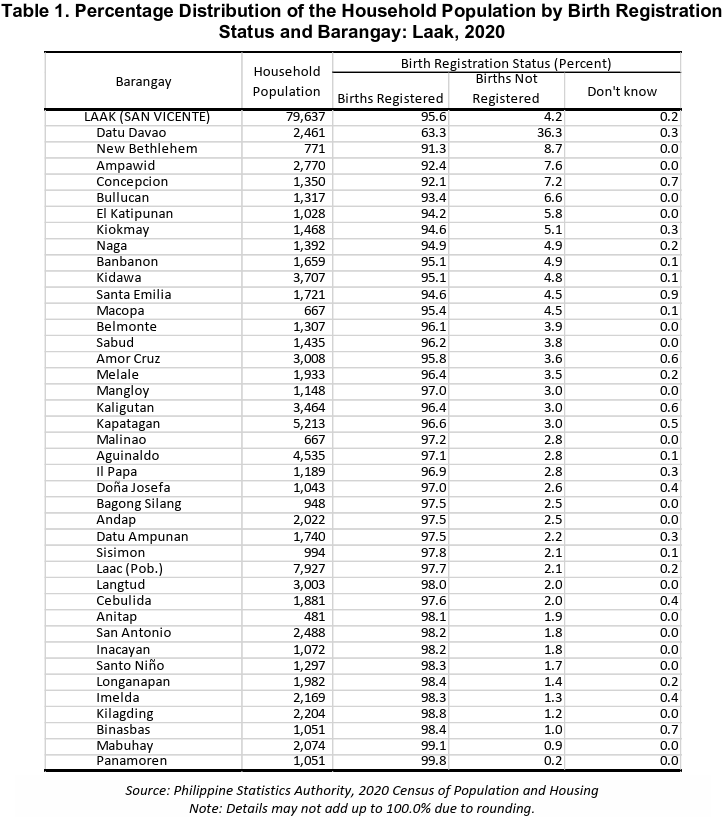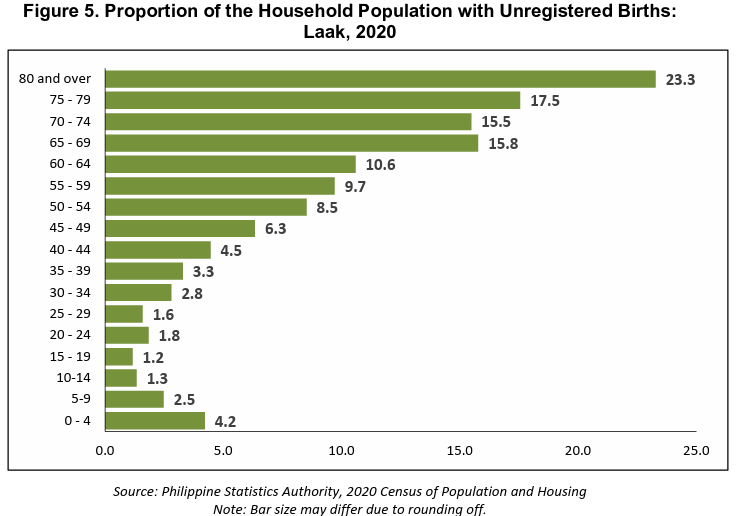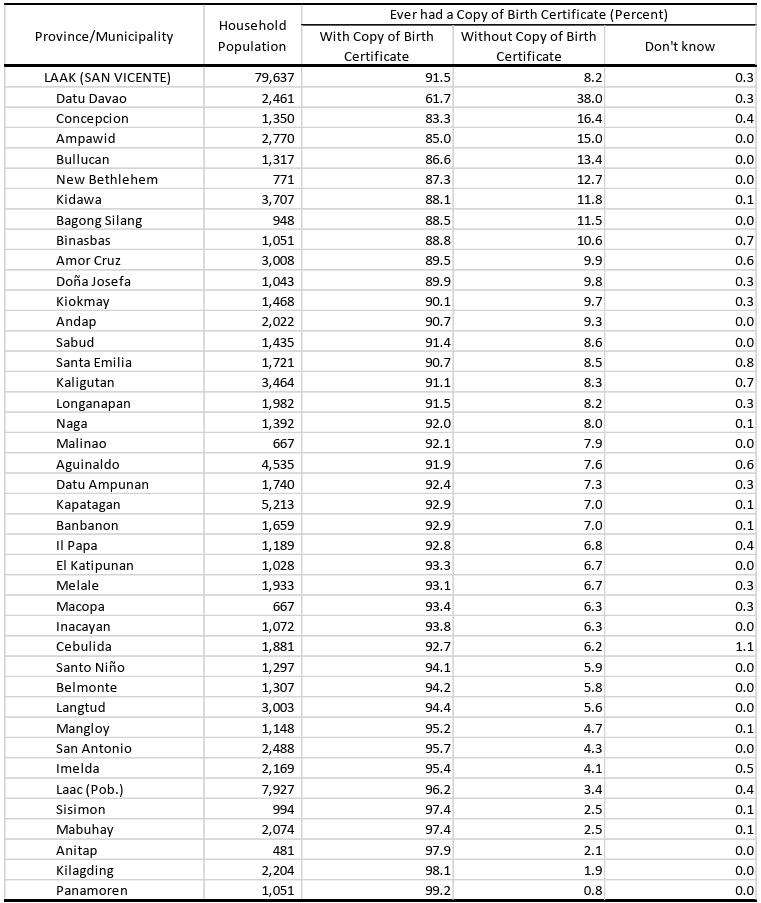Proportion of persons with unregistered births in Laak decreases to 4.2 percent
The 2020 Census of Population and Housing (2020 CPH) revealed that a total of 3,305 persons of the household population in 2020 had their births unregistered with the Local Civil Registry Office (LCRO) of Laak. This is equivalent to 4.2 percent of the 79,637 household population in 2020. (Figure 1)
Moreover, census results from 2015 to 2020 show a decreasing trend in the proportion of persons with unregistered births, from 5.1 percent to 4.2 percent in 2020. (Figure 1)

Laak ranks 4th highest in the proportion of persons with unregistered births
In 2020, Davao de Oro reported a 3.6 percent of the household population whose births were unregistered with the LCROs. At the municipal level, Monkayo posted the highest with 5.5 percent of the household population. This was followed by Mabini and New Bataan with 4.9 percent and 4.5 percent, respectively. (Figure 2)
Meanwhile, Laak recorded a proportion of 4.2 percent and tied with Mawab as ranked 4th in the province with the highest proportion of persons with unregistered births. These two municipalities also posted a proportion higher than the provincial level. (Figure 2)

On the other hand, Nabunturan posted the lowest proportion of persons with unregistered births (2.4%), followed by Pantukan (2.6%), Montevista (2.8%) and Maco (3.0%). (Figure 2)
Proportion of persons with unregistered births is highest in Datu Davao; lowest in Panamoren
Among the 40 barangays, Datu Davao posted the highest proportion of the household population whose births were reported to be unregistered at 36.3 percent, corresponding to 894 persons out of the 2,461 household population in the barangay. This was also the highest proportion of unregistered births among the 237 barangays in the province.

Datu Davao was followed by New Bethlehem with 8.7 percent (67 persons) and Ampawid with 7.6 percent (211 persons). Nine other barangays posted a proportion higher than the municipal level, namely, Concepcion, Bullucan, El Katipunan, Kiokmay, Naga, Banbanon, Kidawa, Santa Emilia, and Macopa. (Table 1 and Figure 3)

Meanwhile, Panamoren recorded the lowest proportion of unregistered births, at 0.2 percent, followed by Mabuhay (0.9%), Binasbas (1.0%), and Kilagding (1.2%). (Table 1 and Figure 3)
More males than females have unregistered births
Among the 3,305 household population whose births were unregistered with the LCRO, 50.8 percent (1,678) were males, while 49.2 percent (1,627) were females. This translates to a sex ratio of 103 males whose births were unregistered with the LCRO for every 100 females whose births were also unregistered. (Figure 4)

At the barangay level, Datu Davao which had the highest proportion whose births were unregistered with the LCRO also showed a higher percentage of males at 52.6 percent compared to females at 47.4 percent.
The oldest age groups post the highest proportions of unregistered births
Across age groups, the household population aged 80 years old and over had the highest proportion of unregistered births at 23.3 percent. The high proportion was also noted in the age group 75-79 years (17.5%), followed by those in the age groups 65-69 years (15.8%), 70-74 years (15.5%), and 60-64 years (10.6%). (Figure 5)

In contrast, the lowest proportion was recorded in the age group 15-19 years with 1.2 percent. (Figure 5)
Moreover, about 14.6 percent or 940 persons out of 6,435 aged 60 years and above were reported in the census to have unregistered births. This means that about 15 in 100 senior citizens have unregistered births. (Figure 5)
Datu Davao posts the highest proportion of persons who never had a copy of their birth certificates
While 4.2 percent of the household population revealed that their births were unregistered, about 8.2 percent reported that they never had a copy of their birth certificates. A total of 6,547 persons of the 79,637 household population were reported to never had a copy of their birth certificates. (Table 2 and Figure 7)
Table 2. Percentage Distribution of the Household Population with or without Copy of Birth Certificate by Barangay: Laak, 2020

Source: Philippine Statistics Authority, 2020 Census of Population and Housing Note: Details may not add up to 100.0% due to rounding.
Among the 40 barangays, Datu Davao also recorded the highest proportion of household population who never had a copy of their birth certificates, 38.0 percent or 936 persons. It was followed by Concepcion (16.4%), Ampawid (15.0%), and Bullucan (13.4%). (Table 2 and Figure 6)
Figure 6. Proportion of the Household Population who Never had a Copy of Birth Certificate by Barangay: Laak, 2020

Source: Philippine Statistics Authority, 2020 Census of Population and Housing Note: Bar size may differ due to rounding off.
Panamoren posted the lowest proportion of persons who never had a copy of their birth certificates at 0.8 percent, followed by Kilagding at 1.9 percent and Anitap at 2.1 percent. (Table 2 and Figure 6)
TECHNICAL NOTES
The statistics presented in this Special Release were based on the answers and information provided by the respondent or any responsible member of the household to the questions on birth registration about all the household members. For the 2020 CPH, birth registration data of all household members were collected by asking the respondents, “Was ______’s birth registered with the Local Civil Registry Office?” and “Has _____ ever had a copy of his/her birth certificate?”
